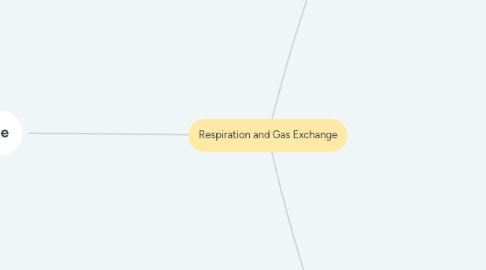
1. Gas Exchange
1.1. human breathing system
1.1.1. nose and mouth
1.1.1.1. thin bones covered in goblet cells that secrete a liquid (mucus and water) which evaporates and helps moisten, as well as traps particles
1.1.1.2. cilia, along with mucus trap dust particles (also found in the trachea and bronchi where they sweep mucus back to throat)
1.1.1.3. warm and humidify air before it reaches to the lungs for gas exchange
1.1.1.4. trachea
1.1.1.4.1. below epiglottis is the larynx (voice box) - tightened by muscles so that they make sound when air passes
1.1.1.4.2. rings of cartilage keep it from collapsing when air pressure is lower inside than outside (pressure changes as you breathe in and out)
1.1.1.4.3. bronchi
1.1.2. inspired and expired air
1.1.2.1. inspired air
1.1.2.1.1. 21% oxygen
1.1.2.1.2. 0.04% carbon dioxide
1.1.2.1.3. variable water vapor
1.1.2.2. expired air
1.1.2.2.1. 16% oxygen
1.1.2.2.2. 4% carbon dioxide
1.1.2.2.3. very high water vapor
1.1.2.3. expired air mixes with normal air in the trachea and bronchi (mixture of air in alveoli and atmospheric air)
1.1.3. breathing movements
1.1.3.1. volume of thorax changes - enlarged when air is sucked in and smaller when air is squeezed out
1.1.3.2. intercostal muscles - between the ribs which raise and lower the rib cage when they contract and relax (also present in the diaphragm)
1.1.3.3. diaphragm - muscle that separates the chest cavity from the abdominal cavity
1.1.3.4. inspiration (breathing in)
1.1.3.4.1. muscles of the diaphragm contract pulling it down
1.1.3.4.2. external intercostal muscles contract
1.1.3.4.3. ribcage upwards and outwards
1.1.3.4.4. pressure inside falls below atmospheric pressure
1.1.3.4.5. volume increased in thorax
1.1.3.5. expiration (breathing out)
1.1.3.5.1. muscles of diaphragm relax and springs back into domed shape
1.1.3.5.2. external intercostal muscles relax
1.1.3.5.3. rib cage drops down to original position
1.1.3.5.4. coughing - internal intercostal muscles contracts strongly making the rib cage drop down
1.1.3.5.5. volume of thorax decreases
1.1.3.6. exercise and breathing rates
1.1.3.6.1. once a limit is reached when the heart and lungs can't pump enough oxygen to the muscle
1.1.3.6.2. control
2. Respiration (metabolic reactions)
2.1. usage
2.1.1. contracting muscles for movement
2.1.2. protein synthesis by linking together amino acids
2.1.3. cell division to repair and grow
2.1.4. active transport to move substances up their concentration gradient
2.1.5. growth
2.1.6. transmitting nerve impulses to transfer information
2.1.7. production of heat to regulate body temperature (warm blooded)
2.1.8. ATP -> (+h20 - hydrolysis) ADP -> AMP -> A
2.2. aerobic respiration (+O2)
2.2.1. series of chemical reactions that take place in the mitochondria, controlled by enzymes using oxygen to break down glucose (and other nutrients) to release energy
2.2.2. glucose + oxygen -> carbon dioxide + water
2.2.3. C6H12O6 + 6O2 -> 6CO2 + 6H2O (+ATP)
2.2.4. 38 molecules of ATP every glucose molecule
2.3. anaerobic respiration (-O2)
2.3.1. series of chemical reaction that take place in the cytoplasm, controlled by enzymes to break down glucose (and other nutrients) to release energy, without oxygen.
2.3.2. not as efficient as not much energy is released per glucose molecule
2.3.3. yeast (single celled fungus)
2.3.3.1. glucose -> alcohol + carbon dioxide
2.3.3.1.1. fermentation - production of alcohol using yeast in the reaction with a sugar
2.3.3.2. C6H12O6 -> 2C2H5OH + 2CO2
2.3.3.3. can do aerobic respiration
2.3.4. plants also respire anaerobically, only for short periods of time
2.3.5. muscle cells (not completely anaerobic)
2.3.5.1. during vigorous exercise when lungs and heart cannot supply oxygen to your muscles as quickly
2.3.5.2. glucose -> lactic acid
2.3.5.2.1. no CO2 produced
3. Experimental
3.1. effect of temperature on respiration in yeast
3.1.1. apparatus
3.1.1.1. retort stands and clamps
3.1.1.2. stopwatch
3.1.1.3. electronic water baths
3.1.1.4. thermometer
3.1.2. instructions
3.1.2.1. check initial temperatures (5)
3.1.2.2. put liquid paraffin and yeast in boiled solution in a beaker - connecting it to a hydrogencarbonate solution
3.1.2.3. stand the tube in first temp and leave it in the water bath for 3-4 mins to give time for the mixture to come to the correct temp
3.1.2.4. start timer and count how many bubbles of gas are released in the right hand side beaker
3.1.2.5. repeat this twice at same temp
3.1.2.6. repeat with all other temps
3.1.2.7. record results in a suitable chart/table and take out average
3.1.2.8. plot a line graph
3.2. the difference in composition between inspired and expired air
3.2.1. apparatus
3.2.1.1. beakers
3.2.1.2. glass tubes
3.2.1.3. rubber tubing
3.2.2. instructions
3.2.2.1. breath gently in and out of the rubber tube until one of the test tubes becomes cloudy
3.2.2.2. other will also become cloudy after a while
3.2.3. safety
3.2.3.1. limewater is irritant - do not get in mouth
3.2.3.2. wear safety goggles when breathing in tube
